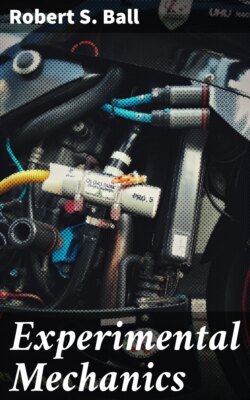Читать книгу Experimental Mechanics - Robert S. Ball - Страница 32
На сайте Литреса книга снята с продажи.
PROPERTY OF THE CENTRE OF GRAVITY
IN A REVOLVING WHEEL.
ОглавлениеTable of Contents
107. There are other curious consequences which follow from the properties of the centre of gravity, and we shall conclude by illustrating one of the most remarkable, which is at the same time of the utmost importance in machinery.
Fig. 30.
108. It is generally necessary that a machine should work as steadily as possible, and that undue vibration and shaking of the framework should be avoided: this is particularly the case when any parts of the machine rotate with great velocity, as, if these be heavy, inconvenient vibration will be produced when the proper adjustments are not made. The connection between this and the centre of gravity will be understood by reference to the apparatus represented in the accompanying figure (Fig. 30). We have here an arrangement consisting of a large cog wheel c working into a small one b, whereby, when the handle h is turned, a velocity of rotation can be given to the iron disk d, which weighs 14 lbs, and is 18" in diameter. This disk being uniform, and being attached to the axis at its centre, it follows that its centre of gravity is also the centre of rotation. The wheels are attached to a stand, which, though massive, is still unconnected with the floor. By turning the handle I can rotate the disk very rapidly, even as much as twelve times in a second. Still the stand remains quite steady, and even the shutter bell attached to it at e is silent.
109. Through one of the holes in the disk d I fasten a small iron bolt and a few washers, altogether weighing about 1 lb.; that is, only one-fourteenth of the weight of the disk. When I turn the handle slowly, the machine works as smoothly as before; but as I increase the speed up to one revolution every two seconds, the bell begins to ring violently, and when I increase it still more, the stand quite shakes about on the floor. What is the reason of this? By adding the bolt, I slightly altered the position of the centre of gravity of the disk, but I made no change of the axis about which the disk rotated, and consequently the disk was not on this occasion turning round its centre of gravity: this it was which caused the vibration. It is absolutely necessary that the centre of gravity of any heavy piece, rotating rapidly about an axis, should lie in the axis of rotation. The amount of vibration produced by a high velocity may be very considerable, even when a very small mass is the originating cause.
110. In order that the machine may work smoothly again, it is not necessary to remove the bolt from the hole. If by any means I bring back the centre of gravity to the axis, the same end will be attained. This is very simply effected by placing a second bolt of the same size at the opposite side of the disk, the two being at equal distances from the axis; on turning the handle, the machine is seen to work as smoothly as it did in the first instance.
111. The most common rotating pieces in machines are wheels of various kinds, and in these the centre of gravity is evidently identical with the centre of rotation; but if from any cause a wheel, which is to turn rapidly, has an extra weight attached to one part, this weight must be counterpoised by one or more on other portions of the wheel, in order to keep the centre of gravity of the whole in its proper place. Thus it is that the driving wheels of a locomotive are always weighted so as to counteract the effect of the crank and restore the centre of gravity to the axis of rotation. The cause of the vibration will be understood after the lecture on centrifugal force (Lect. XVII.).
